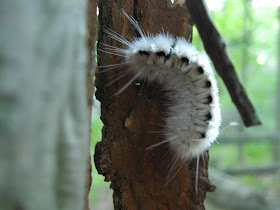Recently, I came across two very fuzzy white caterpillars. I took pictures of them, thinking I would identify them later. But of course that's a more difficult task than I expected.
One of the caterpillars I'm reasonably sure I've identified correctly. I'm pretty sure this is the caterpillar of the American dagger moth (Acronicta americana).

American dagger moth caterpillar, I think. I almost stepped on this one.
(Photo by the Apple Lady)
This freddy can be yellow or white, but most of the pictures online are of the yellow version. So that was one thing that gave me trouble.
It also looks a whole lot like another kind of caterpillar, which I'll get to in a moment. First, some terminology.
The dense fuzzy hairs on the caterpillar are called setae. The caterpillar pictured above has white setae.
The long spiky things that stick up farther than the setae are called lashes. This particular caterpillar has black lashes. One of the tools of identification that entomologists uses is to note on which abdominal segment the lashes appear. In this case, the black lashes are on segments 1 and 3 and 8. The lashes on segments 1 and 3 are paired, but there is only a single black lash on the 8th segment.
These details about the color of the setae and the lashes and the placement of the lashes all match up with descriptions of the American dagger moth, so that's why I'm pretty confident I've got the right name for this dude. Or dudette, as the case may be.
The other one has me stumped.

Hickory tussock moth -- but a variant with white lashes?
(Photo by the Apple Lady)
When I was searching on phrases like "white fuzzy caterpillar black spikes" to identify the previous caterpillar, I kept getting hits for the Hickory tussock moth (Lophocampa caryae). But the one above doesn't have black bands on its abdomen, so I ruled out this species for that caterpillar.
This freddy, however, does have those black bands or spots on its abdomen. It also has thick white setae like the Hickory tussock moth does. It has lashes on what look like maybe the first and seventh segments. But the Hickory tussock moth's lashes are black. This dude's lashes are white.
I can't find a description of any species of caterpillar that has white setae, black spots, and white lashes. So I'm very tempted to say it's a variant version of the Hickory tussock moth caterpillar.
For sure a Hickory tussock moth caterpillar.
(Photo by Brookhaven National Lab)

I've got a couple other tricks up my sleeve to try to identify this freddy. But in the meantime, I thought I'd call on the power of the internet. Does anyone out there know for sure what species of moth caterpillar this is?
Once I've got them both identified with a fairly strong level of certainty, I'll tell you some facts about the life and times of these caterpillars. Here's a teaser: if my identifications are correct, these dudes have some caterpillar-sized amounts of venom in those lashes. So if you touch them, you'll feel a sting like from a mosquito bite or you may get an itchy rash like from poison ivy.
Good thing I didn't actually step on that first one, eh?
Here's the follow-up entry
Thank you for the article. It helped me identify my poisonous white guy
ReplyDeleteThank you for the article. It helped me identify my poisonous white guy
ReplyDelete